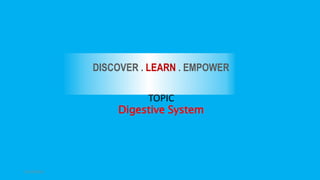
Digestive System.pptx
- 1. DISCOVER . LEARN . EMPOWER TOPIC Digestive System 12/10/2012
- 3. Introduction The digestive system is used for breaking down food into nutrients which then pass intothe circulatory system and are taken to where they are needed in the body.
- 4. Functionsof the DigestiveSystem Ingest food Break down food into nutrient molecules Absorb molecules into the bloodstream Rid the body of indigestibleremains
- 5. Introduction There are four stagesto food processing: 1.Ingestion: taking in food 2.Digestion: breaking down food into nutrients 3.Absorption: taking in nutrients by cells 4.Egestion: removing any leftover wastes
- 6. T Me e t oh um tec hhanically break down food into small pieces. Tongue mixes food with saliva (contains amylase, which helps break down starch). Epiglottis is a flap-like structure at the back of the throat that closes over the trachea preventing food from entering it.
- 7. Partsof the DigestiveSystem Teeth: Grinds your food. Salivary Glands: Produce the salivain your mouth. Tongue: Helps to push food into your esophagus.
- 8. T eeth Four types ofteeth: 1. Incisors 2. Canines 3. Pre – Molars 4. Molars Incisors Canines Premolar Molar
- 10. The tongue is not only one muscle. It is a group of muscles, and it is also what we use to taste food with.
- 11. Canyoureally “swallow” your tongue? Explain. No you can not. The reason is because of the thin layer of tissue that connect your tongue to the bottom of your mouth called the frenulum. Your tongue is also attached to the front and sides of the pharynx.
- 13. © British Nutrition Foundation 2010 Tast e • The tongue can detect five basic tastes: • bitter; • salt; • sour; • sweet; • umami. • Taste may be described by association with a particular food, • e.g. meaty, minty or fruity.
- 14. © British Nutrition Foundation 2010 What is umami? Umami is a savoury taste, often known as the fifth taste. It is a subtle taste and blends well with other tastes. It was discovered by Dr Kikumae Ikeda, from Tokyo Imperial University, Japan, in 1908. He undertook research into Dashi, a traditional Japanese stock made from kombu (kelp). Umami has its own distinct savoury taste, often associated with ripe tomatoes and cheese.
- 15. When you look at your tongue in the mirror you can seeraised areasor “bumps”. What are these raised areas called? These raised areas are called papillae.
- 16. 8.Nameanddescribethe3 different types of papillae. The 3 different types of papillae are: fungiform which are the larger ones located in the front of the tongue; filiform which are the smaller ones in the front; vallate which are the large ones in the back, there are only 8 to 10of these.
- 17. Papillaehave2purposes. Describethem. The purpose of the papillae is to grip the food and with the taste buds they contain. They also “taste” the food.
- 18. So,canyouactually seetaste budswith the nakedeye? Explain. No, you see the papillae, and within the papillae are the taste bubs, and about 100 receptors or “taste” cells make up each taste bud, so you actually see many in one papillae.
- 19. TheHumanDigestiveSystem The tongue pushes food around until it forms a ball called a bolus. The bolus is passed to the pharynx (throat) and the epiglottis makes sure the bolus passes into the esophagus and not down the windpipe!
- 22. TheHuman Digestive System The bolus passing down the esophagus by peristalsis. Peristalsis is a wave of muscular contractions that push the bolus down towards the stomach.
- 23. PeristalsisWaves
- 24. To enter the stomach, the bolus must pass through the esophageal sphincter, a tight muscle that keeps stomach acid out of the esophagus.
- 25. TheHumanDigestiveSystem The stomach has folds called and is a big muscular pouch which turns the bolus and mixes it with gastric juice, a mixture of stomach acid, mucus and enzymes.
- 26. TheHumanDigestiveSystem The acid kills off any invading bacteria or viruses. The enzymes help break down proteins and lipids. The mucus protects the lining of the stomach from being eaten away by the acid.
- 27. TheHumanDigestiveSystem The stomach does do some absorption too. Some medicines (i.e. aspirin), water and alcohol are all absorbed through the stomach. The digested bolus is now called chyme and it leaves the stomach by passing through the pyloric sphincter.
- 28. TheHumanDigestiveSystem Chyme is now in the small intestine. 90% of absorption occurs here. The liver and pancreas help the small intestineto maximize absorption. The small intestine is broken down into three parts:
- 29. Duodenum: The tube that runs from the stomach to the small intestine.
- 30. TheHumanDigestiveSystem 2. Jejunum The jejunum is where the majority of absorption takes place.
- 31. TheHumanDigestiveSystem 3. Ileum The last portion ofthe small intestine is the ileum, compacts the leftovers to pass through into the large intestine.
- 32. Bile, produced in the liver but stored in the gall bladder, breaks down fats. The pancreas secretes a juice to reduce the acidity of the chyme.
- 34. TheHumanDigestiveSystem The large intestine (or colon) is used to absorb water from the waste material leftover and to produce vitamin Kand some Bvitamins using the helpful bacteria that live here.
- 35. TheHumanDigestiveSystem All leftover waste is compacted and stored at the end of the large intestine called the rectum. When full, the anal sphincter loosens and the waste passes outof the body .
- 36. THANK YOU Dr. Vikas Tiwari 12/10/2012